
Whether your company has existed for several years or you’re just starting out, it is important to constantly build up your brand awareness and measure your branding efforts to see what is working and what is not working in your website analytics. One way to measure your brand is separating your site traffic into “branded” and “non-branded” categories within Google Analytics.
Setting Up Google Analytics:
The “branded” category should include:
-
Direct traffic (visits from people typing your website URL directly into the address bar or visits via a browser bookmark)
-
Branded organic search (any organic searched keywords that included your brand name)
-
Branded paid search (any PPC keywords that included your brand name)
The “non-branded” category should consist of any other organic or paid keywords that do not include your brand name.
It’s important to compare these two categories over time to see how and if non-branded searchers eventually become loyal customers that visit your site directly or through searching your brand on Google. To begin measuring your brand in Google Analytics, first setup two Advanced Segments for each category and then setup a Custom Channel Grouping.
Setting up your Advanced Segments in Google Analytics
To find all variations and misspellings of your brand name, analyze your current keywords in Google Analytics to see if any past keywords contained a misspelled version of your brand name or some sort of variation. For example, the company Example Sportz,who sells sneakers for each sport, may notice several visitors searched their brand without a space (examplesportz) or searched their brand using “s” instead of “z” (example sports). I find it beneficial to use additional tools to help save time and generate non-obvious keyword misspellings. SEOBook has a free tool which will do this for you. This tool can be found here: http://tools.seobook.com/spelling/keywords-typos.cgi
For each brand variation/misspelling, create a regular expression by separating each keyword with a vertical line. For example the regular expression for Example Sportz would be:(example sportz|examplesportz|example sports|examplesports|xample sportz|eample sportz)
Now that you have your regular expression with your brand name and variations, go to Advanced Segments in Google Analytics and click +New Custom Segment. Set your conditions similar to the examples below. Figure 1 is the “Branded Search and Direct Traffic” segment that includes direct traffic or traffic from keywords that match your regular expression. Figure 2 is the “Non-Branded Search” segment that excludes traffic from keywords that matches your regular expression and includes traffic from paid and organic only.

Figure 1 – Image from Google Analytics

Figure 2 – Image from Google Analytics
Setting up your Custom Channel Groupings in Google Analytics
Navigate to Channel Groupings after clicking Admin and then Assets in Google Analytics. Click +Create new Channel Groupings and give a descriptive name to the new channel grouping such as “Branded vs. Non-Branded,” and begin adding rules. Start with the “Branded” conditions, as seen in Figure 3 below. The conditions will be the same as the ones used when setting up advanced segments. Once these conditions are added, select a display color and save the rule. For “Non-Branded” follow the same previous steps, as seen in Figure 4 below.

Figure 3 – Image from Google Analytics

Figure 4 – Image from Google Analytics
Begin Analyzing Branded and Non-Branded
Select each custom advanced segment to view branded or non-branded traffic throughout your Google Analytics reports. By graphing branded visits over time, you can see how successful your brand awareness and marketing efforts have been, if the graph is on an upward trend.
To help improve site conversions, segment your branded keywords and analyze the long tail phrases to see if words such as “scam,” “reviews,” or “testimonials” are included within your branded keyword (ex: “example sportz testimonials”). These searchers are aware of your brand, but they are not 100% comfortable in making a purchase of your product or service, until they read other customer reviews and learn more. To show your brand is trustworthy and reputable, you can create content on your site (if not already available) that displays different customer reviews and testimonials. Overall, this will improve your goal conversion rates.
If you have several different products or services, see which ones are most associated with your brand. For the company Example Sportz, a popular keyword from organic could be “example sportz basketball sneakers.” If you see this is one of your top selling products, take advantage of this brand/product association and focus your marketing efforts on it.
Although the ultimate goal is to gain brand recognition and loyal customers, it is important not to lose sight of your non-branded traffic. Through SEO, you can constantly bring new visitors to your site through non-branded searches. Once these visitors enter your site and learn about your brand, they may not only convert the first time, but they may become returning lifetime visitors. Through advanced segmentation, make sure the non-branded searchers are converting by analyzing metrics to see what landing pages have high bounce rates and what pages have high exit rates. Updating the content, usability and/or design of these pages can improve your conversion rates and increase your site engagement. You should analyze how branded and non-branded traffic work together throughout the conversion process. By using the custom channel grouping, you can view Multi-Channel Funnel reports such as Top Conversions Paths and see what conversion paths began as a non-branded search and ended as branded traffic.
The most successful companies have incredible brand recognition. Once you gain a loyal customer and continue to deliver a great product or service, you won’t lose that customer. Effectively measuring your brand in Google Analytics through advanced segmentation and custom channel groupings will give you almost infinite insights on how to constantly improve your business and keep customers. Remember, the more branded traffic to your site, the more conversions.